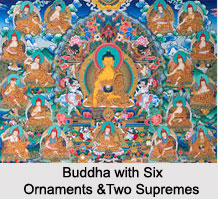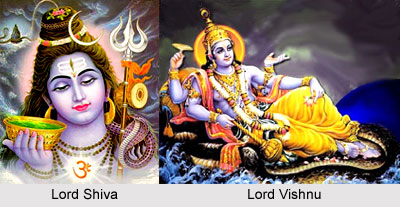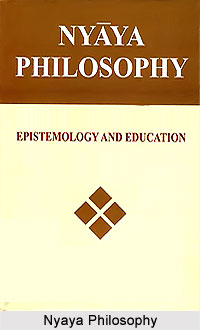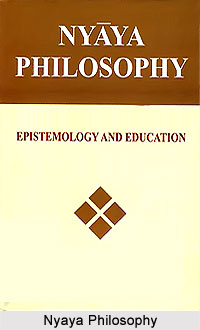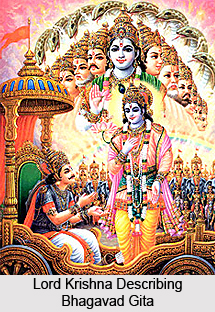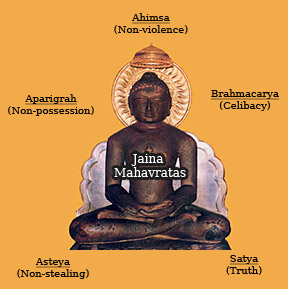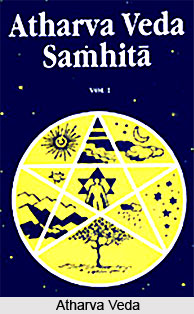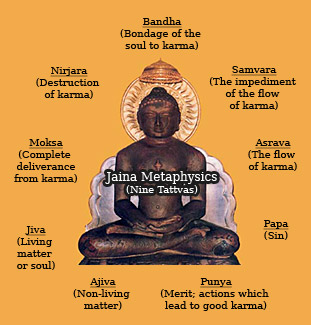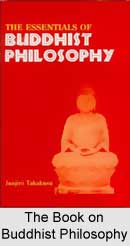 In Indian philosophy, the concept of a self is called atman (i.e., `soul`, or the metaphysical self), which refers to an unchanging, permanent essence conceptualised by virtue of existence. This concept and the associated concept of Brahman, the Vedantic monistic ideal, which was regarded as an ultimate atman for all beings, were requisite for mainstream Indian metaphysics, logic, and science; for all apparent things there had to be an inherent and persistent reality, similar to a Platonic form ( it is a philosophical term, usually used to refer to the idea of realism regarding the existence of universals, after the Greek philosopher Plato, who lived between c. 427-c. 347 B.C.). Buddha rejected all concepts of mtman, laying stress not on permanence, but changeability. He taught that all concepts of a materialistic personal self were incorrect, and took form in the territory of ignorance.
In Indian philosophy, the concept of a self is called atman (i.e., `soul`, or the metaphysical self), which refers to an unchanging, permanent essence conceptualised by virtue of existence. This concept and the associated concept of Brahman, the Vedantic monistic ideal, which was regarded as an ultimate atman for all beings, were requisite for mainstream Indian metaphysics, logic, and science; for all apparent things there had to be an inherent and persistent reality, similar to a Platonic form ( it is a philosophical term, usually used to refer to the idea of realism regarding the existence of universals, after the Greek philosopher Plato, who lived between c. 427-c. 347 B.C.). Buddha rejected all concepts of mtman, laying stress not on permanence, but changeability. He taught that all concepts of a materialistic personal self were incorrect, and took form in the territory of ignorance.
In a number of major Mahayana sutras (e.g. the Mahaparinirvana Sutra, the Tathagatagarbha Sutra, the Srimala Sutra, among others), the Buddha is presented as elucidating this teaching by saying that, while the skandhas (constituents of the ordinary body and mind) are not the self, there does truly exist an everlasting, unchanging, blissful Buddha-essence in all conscious beings. This is the un-created and deathless Buddha-nature ("Buddha-dhatu") or "True Self" of the Buddha himself. The "tathagatagarbha"/Buddha nature does not represent a substantial self (atman); rather, it is a positivistic language expression of "sunyata" (emptiness) and represents the capableness to realise Buddhahood through Buddhist practices; the purpose of the teaching of `tathagatagarbha`/Buddha nature is soteriological (soteriology is a branch of theology that deals with salvation. The term can be used to refer to any kind of religion, and no saviour figure or figures are required) rather than theoretical.
This immaculate Buddhic Self (atman) is in no way to be interpreted as an unremarkable, impermanent, suffering "ego", of which it is the diametrical opposite. On the other hand, this Buddha-essence or Buddha-nature is also often explained as the potential for attaining Buddhahood, rather than a living phenomenon one can grasp onto as being me or self. It is the opposite of a personalised, samsaric "I" or "mine". The paradox is that as soon as the Buddhist practitioner tries to comprehend this inner Buddha potency and clings to it as though it were his or her ego that became more obvious, it proves elusive. It does not "exist" in the time-space conditioned and finite mode in which routined things are embodied. It is presented by the Buddha in the relevant sutras as ultimately incomprehensible, primordially present Reality itself - the living strength for Buddhahood inside all beings. It is eventually revealed (in the last of the Buddha`s Mahayana sutras, the Nirvana Sutra) not as the restricted "no self", the clinging ego (which is indeed anatta/anatman), but as the ever-enduring, egoless Great Self or Dharmakaya of the Buddha.
The scriptural evidence of the Nikyas and gamas is ambivalent with regard to the Buddha`s reported views on the existence or otherwise of a permanent self (tman/atta). Though he is clearly reported to have criticised many of the heterodox concepts concerning an eternal personal self and to have denied the existence of an eternal Self with regards to any of the constituent elements (skandha) of a being, he is nonetheless not reported to have explicitly denied the existence of a non-personal, permanent self, contrary to the popular, orthodox opinion of the Buddha`s teachings. Moreover, when the Buddha predicates "antman" (anatta) with regard to the constituents of a being, there is a grammatical ambivalence in the use of the term. The most natural interpretation is that he is just stating that "the constituents are not the self" rather than "the constituents are devoid of self". This ambivalence was to prove bothersome to Buddhists after Buddha passed away. Some of the foremost schools of Buddhism that developed afterwards maintained the former interpretation, but other influential schools adopted the latter interpretation and took steps to establish their view as the orthodox Buddhist position.
In the Nikayas, the Buddha and his disciples commonly found question or declare "Is that which is impermanent, subject to change, subject to suffering fit to be considered thus: `This I am, this is mine, this is my self`" When completely free from attachments, craving or desire to the five aggregates, such a person experiences then transcends the very causes of suffering. In this way, the insight wisdom or prajna of non-Self gives rise to a ceasing of suffering, and not an intellectual debate over whether a self exists or not.
It is by realising (not merely understanding intellectually, but making real in one`s experience) the three marks of conditioned existence that one develops prajna, which is the antidote to ignorance that lies at the root of all suffering.



